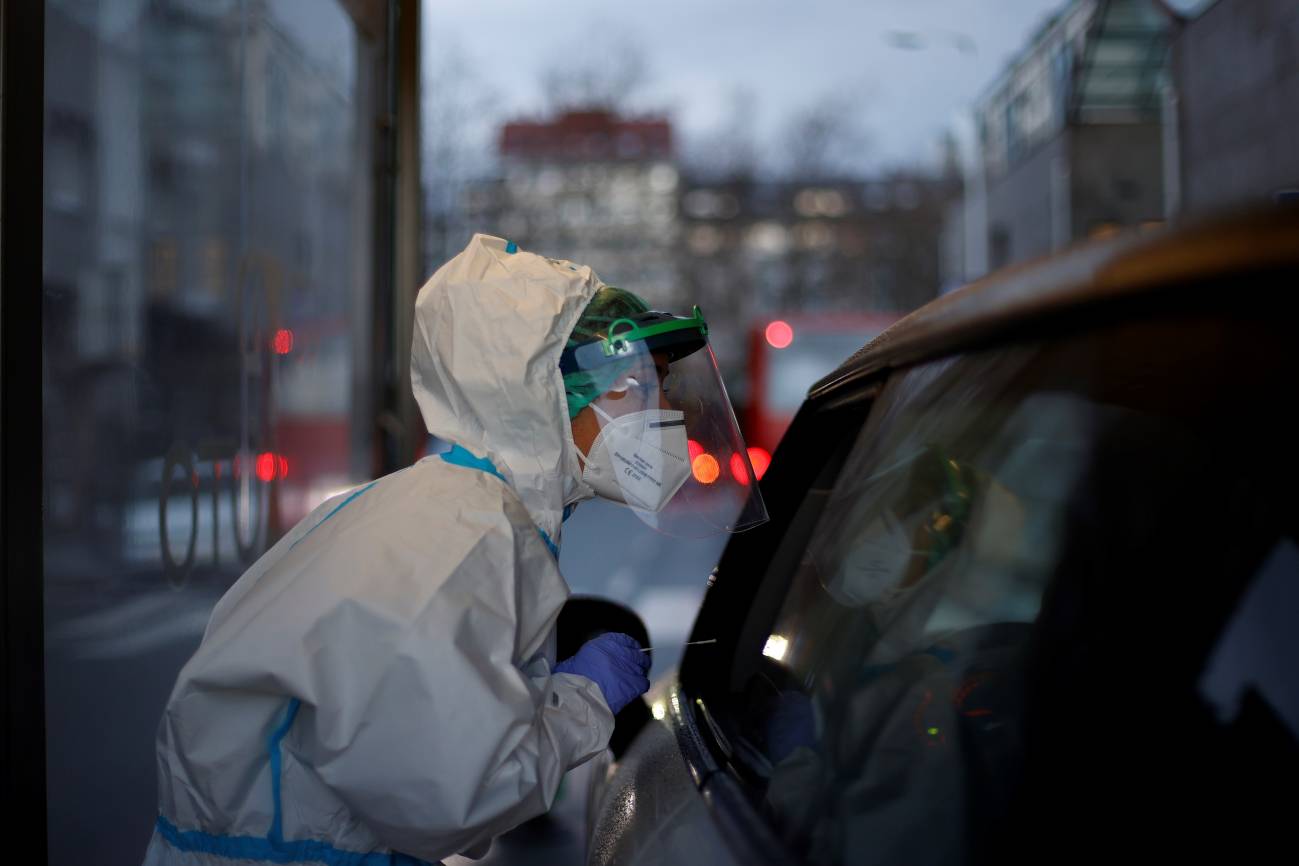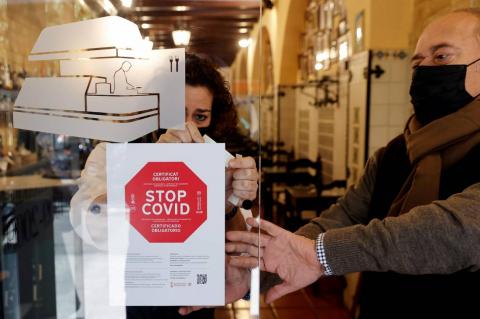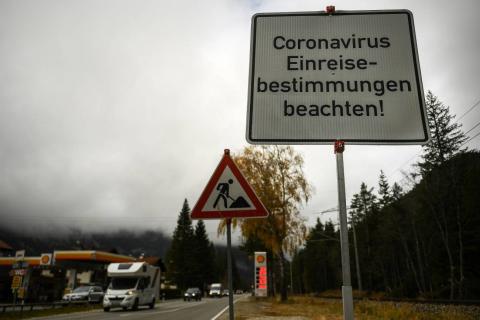Reaction to the announcement that Spain will reduce quarantine and isolation to seven days
In recent days, several countries have modified the quarantine times for close contacts and the isolation of infected people, while others are already considering it. Spain has announced that it will reduce these periods to 7 days, both for people who have tested positive in a test and for close contacts who require quarantine (in the case of our country, unvaccinated people).

Health personnel carry out PCR tests in the "covidauto" at the Ventorrillo health centre in A Coruña / EFE/Cabalar/Archive.
Pedro Gullón - aislamientos 7 días EN
Pedro Gullón
Social epidemiologist and doctor specialising in preventive medicine and public health at the University of Alcalá
Right now we have two debates with very different implications for pandemic control.
On the one hand, there is the debate on reducing the quarantine period (i.e. the period in which a close contact must avoid contact with other people because he or she may be developing the disease). This reduction is motivated by the fact that some data point to a reduction of the incubation period with omicron. That is, the time it takes from the time you have close contact until you develop symptoms or have a positive PCR. If that period is shorter, quarantines could be shorter. The impact of reducing quarantine time is minor as, at least in Spain, vaccinated people have not been quarantined for a few months. Therefore, changes in quarantine time would have an impact especially on families with young unvaccinated children.
On the other hand, reducing the isolation period (the period that a person with symptoms can be contagious) may have further implications. We know that the first few days after the onset of symptoms are the most contagious. But there is no safe cut-off point after which a person will not excrete virus with 100% certainty. In people who are 5 to 7 days after testing positive, and who are completely asymptomatic, the chances of them infecting others are low. However, they are never zero and it is a continuum: the longer the time, the less likely they are to transmit.
Salvador Peiró - aislamientos 7 días EN
Salvador Peiró
Epidemiologist, researcher in the Health Services and Pharmacoepidemiology Research Area of the Foundation for the Promotion of Health and Biomedical Research of the Valencian Community (FISABIO) and Director of Gaceta Sanitaria, the scientific journal of the Spanish Society of Public Health and Health Administration (SESPAS)
It is important to distinguish between isolation (for positives) and quarantine (for close contacts).
1) Reduces isolation for asymptomatic positives (unclear what an asymptomatic is because covid-19 gives many cases with minor symptoms), although it leaves them with 5 added days of rigid use of masks, distance, etc. Symptomatics continue as before.
2) Reduce confinement for close contacts. As above, protective measures are maintained and a test is recommended on the fifth day.
3) Forgive confinement for close contacts with booster dose. Also with protective measures and a test recommendation on day 5.
They motivate this by saying that "science shows that most transmission occurs early in the course of the disease, usually in the one to two days before symptoms appear and in the two to three days after". While that is true for the majority of cases, I have no idea of the size of the minority of cases that continue to transmit on day six or their importance in transmission. As far as I know, there is no direct evidence on that issue.
On balance the measure seems to me sensible and almost necessary.
I estimate that Omicron is going to produce a major social disruption (we have around 100,000 cases and we are doubling every 5-6 days). In 10 days we could have to isolate more than 200,000 people (and if we add four contacts per case, we reach a million), and so on for several days with 10 days of isolation or quarantine for each one. It would affect firefighters, police, trains, food distribution, media. After 10 days it would be almost a general confinement, but based on isolating and quarantining one person at a time for 10 days. And most of them without symptoms or with very mild symptoms. On the other hand, in close health contacts, we have had a close policy for some time (and without 5 days, although with tests).
However, I don't think it will be enough. At this rate of infection and with the current strategy, we will exhaust our PCR capacity and it will be increasingly difficult to obtain reagents. Spending tests on asymptomatic people (and on people who, quite reasonably, want to go out for dinner or party) will make it difficult for us to have capacity for essential professions. Assuming that (at least as long as hospitals do not get much worse and except for some ACs) effective transmission reduction strategies (strategies to reduce interactions between people) will not be adopted, which would be reasonable at this point, there are many things we could do to make room for the most necessary care (moving to self-care for mild cases and a few other things) and reduce social disruption as much as possible.
Although we hear a lot of positive talk that the wave will be swift, swift in this is not a good thing. It is all cases at once. In fact, the goal of reducing interactions now would be to slow down the progression of omicron in order to extend the wave and buy time for the third doses.
The problem with all this is that experts and administrations have generated a lot of confusion and mistrust these days with measures of no use that have been strongly contested in all the media by experts, with tests for meetings, with the bet that we are not going to have so many hospitalisations (which depends on the relationship between the reduction in severity and the increase in cases), with the recourse to the mildness of the infection or that now it is a cold (which may be true for the most part, but not in aggregate) and even with the end of the pandemic.
With this basic mistrust, measures of this type will be perceived as abandonment (like cutbacks: we are no longer tested, and the infected are released to work even if they are contagious). They will create social unrest. And a lot of it in specific groups of civil servants. I have the impression that the terrible communication of these weeks has created a very unmanageable situation for the use of rational measures that additionally require an excellent communication to the population (self-care) and a good social acceptance.
Translated with www.DeepL.com/Translator (free version)
Óscar Zurriaga - aislamientos 7 días EN
Óscar Zurriaga
Professor of Preventive Medicine and Public Health at the University of Valencia and outgoing president of the Spanish Society of Epidemiology (SEE).
This is a difficult issue because there is no single answer.
Quarantine of close contacts is a fundamental measure to try to control transmission of the virus. But it is also crucial that it is done in the right way. It is not just about time: it is also about limiting contact with other people.
In a situation of extensive community transmission, it is possible to reduce this period, provided that during the remaining 10 days there is also a limitation of activities (avoiding being with many people, or in crowded places) and that strict personal protection measures are maintained (always wearing a mask, physical distance, ventilation, avoiding enclosed places).
Adrián Aginagalde - aislamientos 7 días EN
Adrian Hugo Aginagalde
Spokesperson of the Spanish Society of Preventive Medicine, Public Health and Health Management (SEMPSPGS), Head of Service of the Epidemiological Surveillance and Health Information Unit of Gipuzkoa and, previously, Head of Service of the Population Screening Programmes Unit at the Ministry of Health
At present, a transmission period and an incubation period (10+10 days) have not yet elapsed since the first generation of cases of the Omicron variant, so it is very difficult to assess whether there is transmission from day 5 onwards.
In addition, most close contacts are identified within the first few days of symptoms, making it even more difficult to assess empirically whether or not transmission is occurring.
Nevertheless, taking the delta variant as a reference, the percentage of secondary cases that could escape seems low.
A European consensus along the lines of the ECDC guideline seems imperative to maintain common actions.



